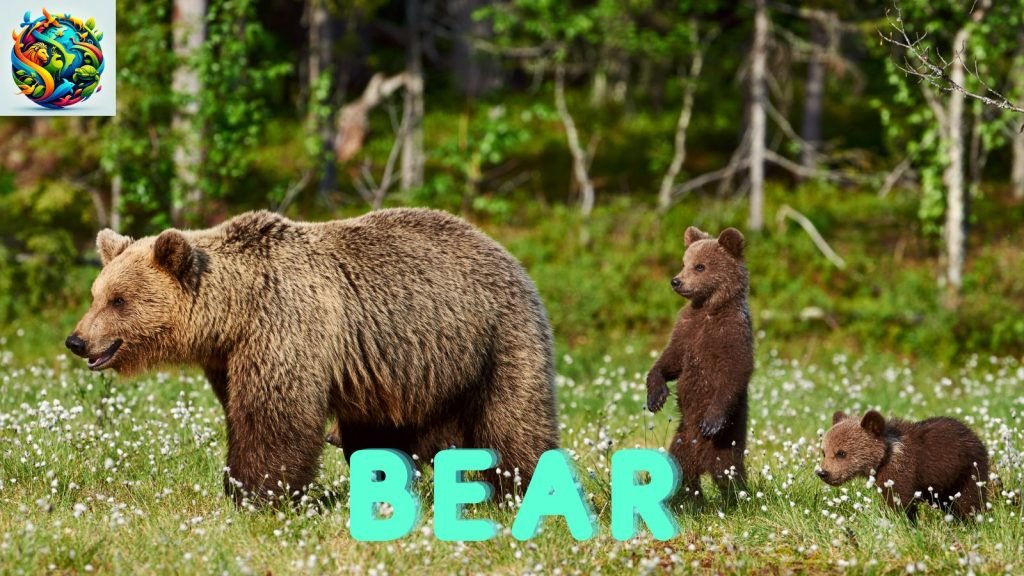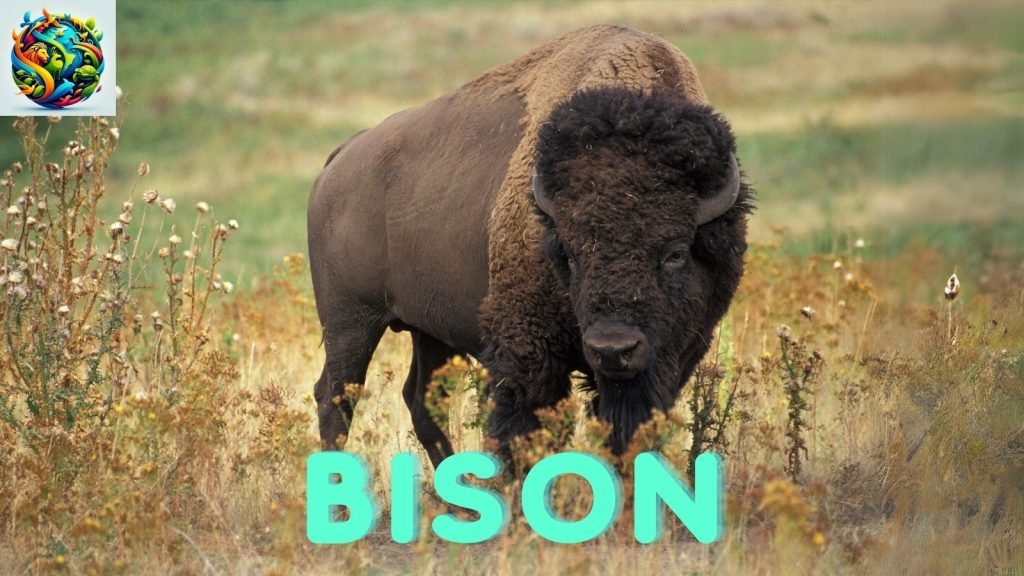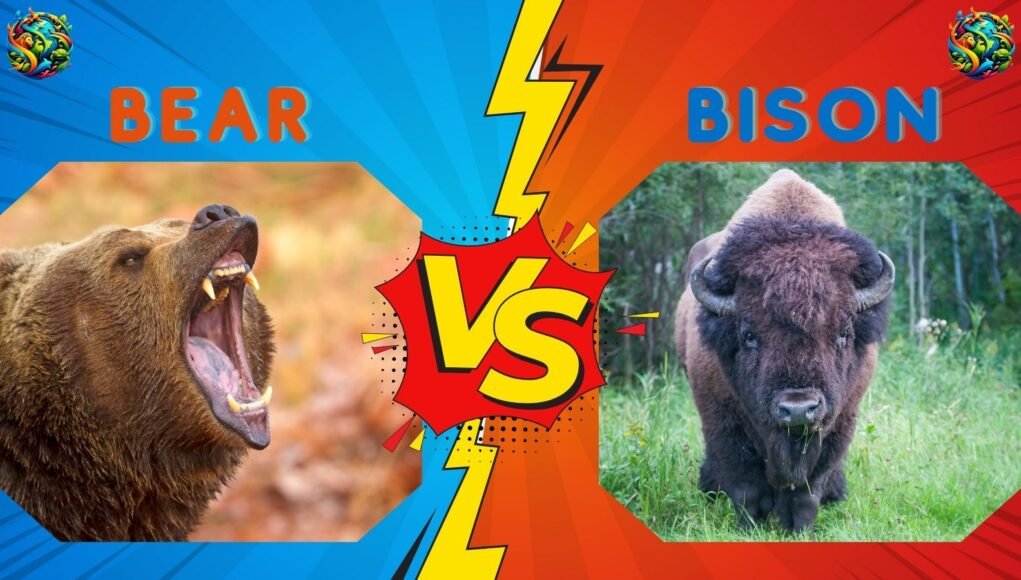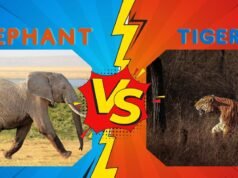Bear vs Bison: A Titan Clash of Raw Strength, Defense, and Survival
The bear vs bison matchup is a thrilling clash between two of the most powerful and iconic animals in the wild. On one side, we have the bear, a versatile and intelligent predator known for its strength, claws, and adaptability. On the other side, we have the bison, a massive herbivore equipped with a muscular build, sharp horns, and a tenacious fighting spirit. This battle raises intriguing questions: Would the bear’s predatory instincts and weaponry give it the upper hand? Or would the bison’s sheer size, strength, and defensive tactics allow it to hold its own? Let’s dive into this epic showdown and analyze the strengths and weaknesses of each contender.
Basic Overview of the Two Competitors

The Bear
Bears are large, powerful mammals known for their strength, intelligence, and adaptability.
- Scientific Name: Ursus spp. (e.g., Brown Bear: Ursus arctos)
- Size: Bears vary in size depending on the species, but the largest, such as the Kodiak bear, can weigh between 330 and 1,500 pounds (150–680 kg) and stand 5 to 10 feet tall when upright.
- Habitat: Bears are found in forests, mountains, tundras, and coastal areas across North America, Europe, and Asia.
- Diet: Bears are omnivorous, feeding on berries, fish, small mammals, and occasionally large prey like deer or bison.
- Social Behavior: Bears are mostly solitary animals, except during mating season or when raising cubs.
- Speed: Bears can run at speeds of up to 35 miles per hour (56 km/h) in short bursts.
- Bite Force: Bears have a bite force of approximately 1,200 psi (Brown Bear).
- Defensive Traits: Bears have thick fur, a layer of fat, and powerful forelimbs with sharp claws for defense and attack.
The Bison

The bison is one of the largest land mammals in North America, known for its massive size, muscular build, and sharp horns.
- Scientific Name: Bison bison
- Size: Bison weigh between 1,000 and 2,200 pounds (450–1,000 kg) and stand 5 to 6.5 feet tall at the shoulder.
- Habitat: Bison are found in grasslands, prairies, and forests across North America.
- Diet: Bison are herbivorous, feeding on grasses, shrubs, and other vegetation.
- Social Behavior: Bison live in herds, which are led by a dominant male.
- Speed: Bison can run at speeds of up to 35 miles per hour (56 km/h) in short bursts.
- Bite Force: Bison have a bite force of approximately 400 psi, which is relatively weak compared to predators.
- Defensive Traits: Bison rely on their size, sharp horns, and powerful legs to defend themselves. They can deliver devastating charges and use their horns to gore opponents.



Key Comparisons: Bear vs Bison
1. Size & Strength
Bison are significantly larger and heavier than bears, with some individuals weighing up to 2,200 pounds. However, bears are more muscular and have powerful forelimbs for grappling.
Winner: Bison (in size), Bear (in strength and grappling ability)
2. Speed & Agility
Both animals are surprisingly fast, capable of reaching speeds of up to 35 miles per hour. However, bears are more agile and can change direction quickly, while bison rely more on their size and strength.
Winner: Bear
3. Intelligence & Strategy
Bears are highly intelligent and use problem-solving skills and strategic thinking to hunt and defend themselves. Bison, while not as intelligent, are effective at using their environment and physical abilities to defend themselves.
Winner: Bear
4. Offensive & Defensive Weaponry
Bears have sharp claws, powerful jaws, and a bite force of 1,200 psi, which they use to deliver fatal bites and slashes. Bison, on the other hand, have sharp horns and powerful legs that they use to deliver devastating charges and gore opponents.
Winner: Bear (claws and bite), Bison (horns and charges)
5. Fighting Style
Bears rely on their strength, claws, and intelligence to overpower opponents. They can stand on their hind legs to intimidate and strike with their forelimbs. Bison use their size, horns, and powerful legs to defend themselves, often delivering powerful charges or using their horns to gore opponents.
Winner: Bear (in most cases), Bison (if it can land a powerful charge or gore)
Bear vs Bison Fight Scenarios:
Scenario 1: One-on-One Battle on Land
In a one-on-one battle on land, the bear would use its speed and agility to try to outmaneuver the bison. It would attempt to deliver powerful blows with its forelimbs and claws, targeting the bison’s neck or flanks. The bison, in turn, would use its horns and powerful legs to strike back. However, the bear’s agility and strength would likely give it the upper hand, allowing it to overpower the bison.
Winner: Bear
Scenario 2: One-on-One Battle in Water
In water, the bison would have a slight advantage due to its swimming ability. Bison are strong swimmers and can use their powerful legs to defend themselves. The bear, while a capable swimmer, would struggle to match the bison’s strength and agility in water.
Winner: Bison
Scenario 3: Bear vs Bison Herd
In a scenario where a bear faces a herd of bison, the outcome would be more balanced. Bison are social animals and may cooperate when defending themselves. While the bear could take down a few bison, it would eventually be overwhelmed by their numbers and powerful charges.
Winner: Bison Herd
Final Verdict: Bear vs Bison Who Would Win?
After analyzing every aspect of the bear vs bison battle, here’s the final breakdown:
| Category | Winner |
|---|---|
| Bear vs Bison Size & Strength | Bison (in size), Bear (in strength) |
| Bear vs Bison Speed & Agility | Bear |
| Bear vs Bison Intelligence & Strategy | Bear |
| Bite Force | Bear |
| Weapons (Claws, Strength) | Bear (claws), Bison (horns and charges) |
| Bear vs Bison Combat Strategy | Bear (strength and intelligence), Bison (powerful charges and horns) |
| Bear vs Bison Survival Skills | Bear (versatility), Bison (size and strength) |
Ultimate Winner: Bear in One-on-One Combat, Bison Herd in Group Combat
- In a one-on-one battle, the bear wins 70% of the time due to its agility, strength, and intelligence.
- In water, the bison has a slight advantage due to its swimming ability.
- In a herd scenario, bison could overwhelm the bear with their numbers and powerful charges.
Conclusion
The bear’s strength, intelligence, and versatility make it a dominant predator in one-on-one combat. However, the bison’s size, powerful legs, and horns give it a significant advantage in group scenarios. While the bear is likely to dominate in most one-on-one encounters, the bison’s unique adaptations and defensive tactics make it a formidable opponent. This matchup highlights the fascinating dynamics of predator-prey interactions and the importance of both individual strength and environmental adaptation in the animal kingdom. Whether it’s the bear’s raw power or the bison’s devastating charges, this battle reminds us of the incredible diversity of nature’s most powerful creatures.




